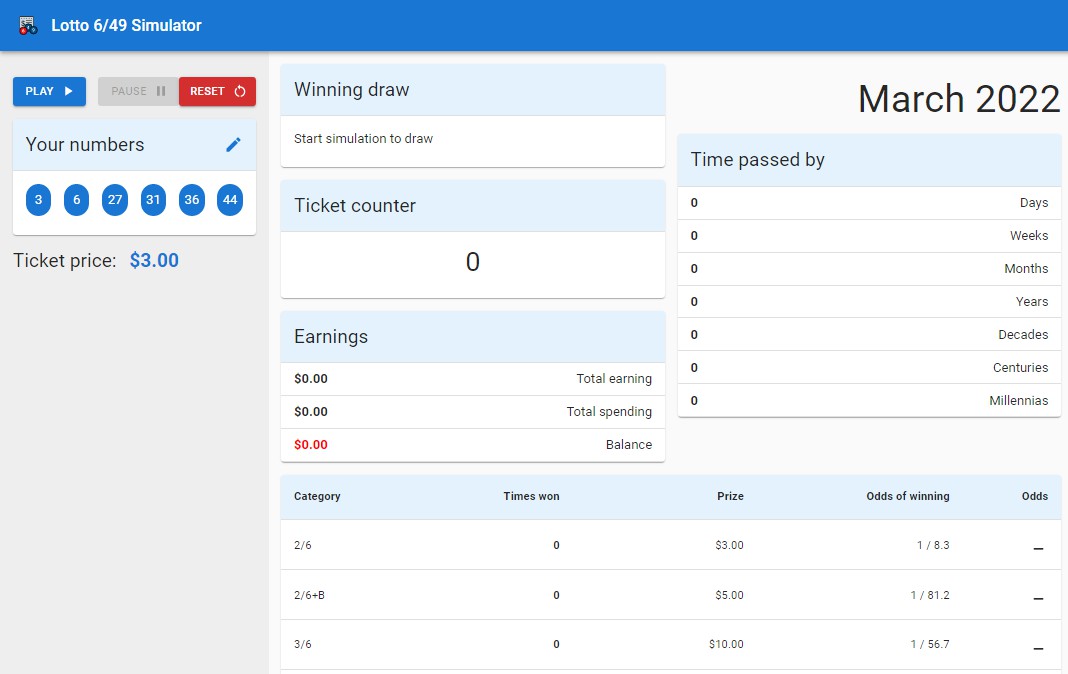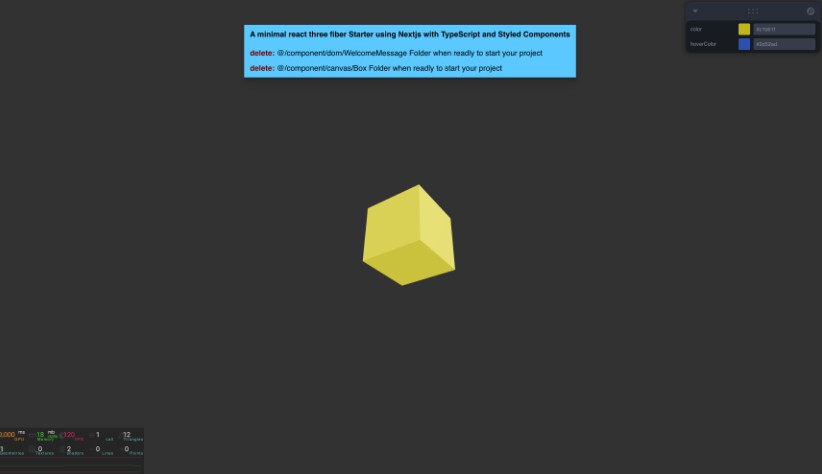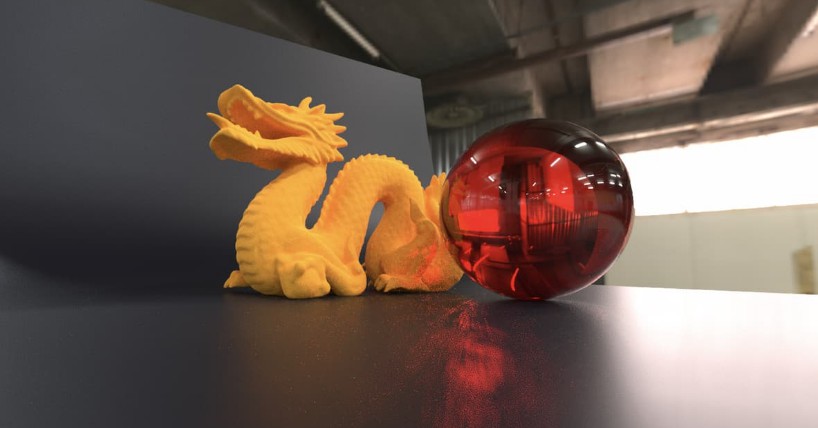lamina
? An extensible, layer based shader material for ThreeJS
These demos are real, you can click them! They contain the full code, too. ?
lamina let’s you create materials with a declarative, system of layers. Layers make it incredibly easy to stack and blend effects. This approach was first made popular by the Spline team.
import { LayerMaterial, Color } from 'lamina'
function GradientSphere() {
return (
<Sphere>
<LayerMaterial
color="#ffffff" //
shading="physical"
transmission={1}
>
<Depth
colorA="#810000" //
colorB="#ffd0d0"
alpha={0.5}
mode="multiply"
near={0}
far={2}
origin={[1, 1, 1]}
/>
</LayerMaterial>
</Sphere>
)
}
Show Vanilla example
Lamina can be used with vanilla Three.js. Each layer is just a class.
import { LayerMaterial, Color } from 'lamina/vanilla'
const geometry = new THREE.SphereGeometry(1, 128, 64)
const material = new LayerMaterial({
color: '#d9d9d9',
shading: 'physical',
transmission: 1,
layers: [
new Depth({
colorA: '#002f4b',
colorB: '#f2fdff',
alpha: 0.5,
mode: 'multiply',
near: 0,
far: 2,
origin: new THREE.Vector3(1, 1, 1),
}),
],
})
const mesh = new THREE.Mesh(geometry, material)
Note: To match the colors of the react example, you must convert all colors to Linear encoding like so:
new Depth({
colorA: new THREE.Color('#002f4b').convertSRGBToLinear(),
colorB: new THREE.Color('#f2fdff').convertSRGBToLinear(),
alpha: 0.5,
mode: 'multiply',
near: 0,
far: 2,
origin: new THREE.Vector3(1, 1, 1),
}),
Layers
LayerMaterial
LayerMaterial can take in the following parameters:
| Prop | Type | Default |
|---|---|---|
name |
string |
"LayerMaterial" |
color |
THREE.ColorRepresentation | THREE.Color |
"white" |
alpha |
number |
1 |
shading |
'phong' | 'physical' | 'toon' | 'basic' | 'lambert' | 'standard' |
'basic' |
layers* |
Abstract[] |
[] |
The shading prop controls the shading that is applied on the material. The material then accepts all the material properties supported by ThreeJS of the material type specified by the shading prop.
* Note: the layers prop is only available on the LayerMaterial class, not the component. Pass in layers as children in React.
Built-in layers
Here are the layers that lamina currently provides
| Name | Function |
|---|---|
| Fragment Layers | |
Color |
Flat color. |
Depth |
Depth based gradient. |
Fresnel |
Fresnel shading (strip or rim-lights). |
Gradient |
Linear gradient. |
Matcap |
Load in a Matcap. |
Noise |
White, perlin or simplex noise . |
Normal |
Visualize vertex normals. |
Texture |
Image texture. |
| Vertex Layers | |
Displace |
Displace vertices using. noise |
See the section for each layer for the options on it.
Debugger
Lamina comes with a handy debugger that lets you tweek parameters till you’re satisfied with the result! Then, just copy the JSX and paste!
Replace LayerMaterial with DebugLayerMaterial to enable it.
<DebugLayerMaterial color="#ffffff">
<Depth
colorA="#810000" //
colorB="#ffd0d0"
alpha={0.5}
mode="multiply"
near={0}
far={2}
origin={[1, 1, 1]}
/>
</DebugLayerMaterial>
Any custom layers are automatically compatible with the debugger. However, for advanced inputs, see the Advanced Usage section.
Writing your own layers
You can write your own layers by extending the Abstract class. The concept if simple:
Each layer can be treated as an isolated shader program that produces a
vec4color.
The color of each layer will be blended together using the specified blend mode. A list of all available blend modes can be found here
// Extend the Abstract layer
class CustomLayer extends Abstract {
// Define stuff as static properties!
// Uniforms: Must begin with prefix "u_".
// Assign them their default value
static u_color = 'red'
static u_alpha = 1
// Define your fragment shader just like you already do!
// Only difference is, you must return the final color of this layer
static fragmentShader = `
uniform vec3 u_color;
uniform float u_alpha;
// Varyings must be prefixed by "v_"
varying vec3 v_Position;
vec4 main() {
// Local variables must be prefixed by "f_"
vec4 f_color = vec4(u_color, u_alpha)
return f_color;
}
`
// Optionally Define a vertex shader!
// Same rules as fragment shaders, except no blend modes.
static vertexShader = `
// Varyings must be prefixed by "v_"
varying vec3 v_Position;
void main() {
v_Position = position;
return position * 2.;
}
`
constructor(props) {
// You MUST call `super` with the current constructor as the first argument.
// Second argument is optional and provides non-uniform parameters like blend mode, name and visibility.
super(CustomLayer, {
name: 'CustomLayer',
...props,
})
}
}
If you need a specialized or advance use-case, see the Advanced Usage section
Using your own layers
Custom layers are Vanilla compatible by default.
To use them with React-three-fiber, you must use the extend function to add the layer to your component library!
import { extend } from "@react-three/fiber"
extend({ CustomLayer })
// ...
const ref = useRef();
// Animate uniforms using a ref
useFrame(({ clock }) => {
ref.current.color.setRGB(
Math.sin(clock.elapsedTime),
Math.cos(clock.elapsedTime),
Math.sin(clock.elapsedTime),
)
})
<LayerMaterial>
<customLayer
ref={ref} // Imperative instance of CustomLayer. Can be used to animate unifroms
args={[]} // Non uniform arguments, i.e. props param on constructor
color="green" // Uniforms can be set directly
alpha={0.5}
/>
</LayerMaterial>
Advanced Usage
For more advanced custom layers, lamina provides the onParse event.
This event runs after the layer’s shader and uniforms are parsed.
This means you can use it to inject functionality that isn’t by the basic layer extension syntax.
Here is a common use case – Adding non-uniform options to layers that directly sub out shader code.
class CustomLayer extends Abstract {
static u_color = 'red'
static u_alpha = 1
static vertexShader = `...`
static fragmentShader = `
// ...
float f_dist = lamina_mapping_template; // Temp value, will be used to inject code later on.
// ...
`
// Get some shader code based off mapping parameter
static getMapping(mapping) {
switch (mapping) {
default:
case 'uv':
return `some_shader_code`
case 'world':
return `some_other_shader_code`
}
}
// Set non-uniform defaults
mapping: 'uv' | 'world' = 'uv'
constructor(props) {
super(
CustomLayer,
{
name: 'CustomLayer',
...props,
},
// This is onParse callback
(self: CustomLayer) => {
// Add to Leva (debugger) schema.
// This will create a dropdown select component on the debugger.
self.schema.push({
value: self.mapping,
label: 'mapping',
options: ['uv', 'world'],
})
// Get shader chunk based off selected mapping value
const mapping = CustomLayer.getMapping(self.mapping)
// Inject shader chunk in current layer's shader code
self.fragmentShader = self.fragmentShader.replace('lamina_mapping_template', mapping)
}
)
}
}
Layers
Every layer has these props in common.
| Prop | Type | Default |
|---|---|---|
mode |
BlendMode |
"normal" |
name |
string |
<this.constructor.name> |
visible |
boolean |
true |
All props are optional.
Color
Flat color.
| Prop | Type | Default |
|---|---|---|
color |
THREE.ColorRepresentation | THREE.Color |
"red" |
alpha |
number |
1 |
Normal
Visualize vertex normals
| Prop | Type | Default |
|---|---|---|
direction |
THREE.Vector3 | [number,number,number] |
[0, 0, 0] |
alpha |
number |
1 |
Depth
Depth based gradient. Colors are lerp-ed based on mapping props which may have the following values:
vector: distance fromoriginto fragment’s world position.camera: distance from camera to fragment’s world position.world: distance from fragment to center (0, 0, 0).
| Prop | Type | Default |
|---|---|---|
colorA |
THREE.ColorRepresentation | THREE.Color |
"white" |
colorB |
THREE.ColorRepresentation | THREE.Color |
"black" |
alpha |
number |
1 |
near |
number |
2 |
far |
number |
10 |
origin |
THREE.Vector3 | [number,number,number] |
[0, 0, 0] |
mapping |
"vector" | "camera" | "world" |
"vector" |
Fresnel
Fresnel shading.
| Prop | Type | Default |
|---|---|---|
color |
THREE.ColorRepresentation | THREE.Color |
"white" |
alpha |
number |
1 |
power |
number |
0 |
intensity |
number |
1 |
bias |
number |
2 |
Gradient
Linear gradient based off distance from start to end in a specified axes. start and end are points on the axes selected. The distance between start and end is used to lerp the colors.
| Prop | Type | Default |
|---|---|---|
colorA |
THREE.ColorRepresentation | THREE.Color |
"white" |
colorB |
THREE.ColorRepresentation | THREE.Color |
"black" |
alpha |
number |
1 |
contrast |
number |
1 |
start |
number |
1 |
end |
number |
-1 |
axes |
"x" | "y" | "z" |
"x" |
mapping |
"local" | "world" | "uv" |
"local" |
Noise
Various noise functions.
| Prop | Type | Default |
|---|---|---|
colorA |
THREE.ColorRepresentation | THREE.Color |
"white" |
colorB |
THREE.ColorRepresentation | THREE.Color |
"black" |
colorC |
THREE.ColorRepresentation | THREE.Color |
"white" |
colorD |
THREE.ColorRepresentation | THREE.Color |
"black" |
alpha |
number |
1 |
scale |
number |
1 |
offset |
THREE.Vector3 | [number, number, number] |
[0, 0, 0] |
mapping |
"local" | "world" | "uv" |
"local" |
type |
"perlin' | "simplex" | "cell" | "curl" |
"perlin" |
Matcap
Set a Matcap texture.
| Prop | Type | Default |
|---|---|---|
map |
THREE.Texture |
undefined |
alpha |
number |
1 |
Texture
Set a texture.
| Prop | Type | Default |
|---|---|---|
map |
THREE.Texture |
undefined |
alpha |
number |
1 |
BlendMode
Blend modes currently available in lamina
normal |
divide |
|---|---|
add |
overlay |
subtract |
screen |
multiply |
softlight |
lighten |
reflect |
darken |
negation |
Vertex layers
Layers that affect the vertex shader
Displace
Displace vertices with various noise.
| Prop | Type | Default |
|---|---|---|
strength |
number |
1 |
scale |
number |
1 |
mapping |
"local" | "world" | "uv" |
"local" |
type |
"perlin' | "simplex" | "cell" | "curl" |
"perlin" |
offset |
THREE.Vector3 | [number,number,number] |
[0, 0, 0] |







